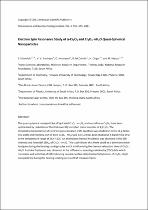 ResearchSpace
ResearchSpace
Electron spin resonance study of a-Cr2O3 and Cr2O3·nH2O quasi-spherical nanoparticles
JavaScript is disabled for your browser. Some features of this site may not work without it.
- ResearchSpace
- →
- Research Publications/Outputs
- →
- Journal Articles
- →
- View Item
| dc.contributor.author |
Khamlich, S

|
|
| dc.contributor.author |
Srinivasu, VV

|
|
| dc.contributor.author |
Nemraoui, O

|
|
| dc.contributor.author |
McCrindle, R

|
|
| dc.contributor.author |
Cingo, N

|
|
| dc.contributor.author |
Maaza, M

|
|
| dc.date.accessioned | 2012-04-20T11:37:32Z | |
| dc.date.available | 2012-04-20T11:37:32Z | |
| dc.date.issued | 2011-12 | |
| dc.identifier.citation | Khamlich, S, Srinivasu, VV, Nemraoui, O, McCrindle, R, Cingo, N and Maaza, M. 2011. Electron spin resonance study of a-Cr2O3 and Cr2O3·nH2O quasi-spherical nanoparticles. Nanoscience and Nanotechnology Letters, vol. 3(4), pp 550-555 | en_US |
| dc.identifier.issn | 1941-4900 | |
| dc.identifier.uri | http://www.ingentaconnect.com/content/asp/nnl/2011/00000003/00000004/art00018 | |
| dc.identifier.uri | http://docserver.ingentaconnect.com/deliver/connect/asp/19414900/v3n4/s18.pdf?expires=1334920229&id=68398559&titleid=72010039&accname=CSIR+Acquisitions+%28Serials%29&checksum=E9C3EFDB96D25749976D03226C5AA634 | |
| dc.identifier.uri | http://hdl.handle.net/10204/5804 | |
| dc.description | Copyright: 2011 American Scientific Publishers. This is an ABSTRACT ONLY. | en_US |
| dc.description.abstract | The quasi-spherical nanoparticles of hydrated Cr2O3 · nH2O, and crystalline -Cr2O3, have been synthesized by reduction of the first row (3d) transition metal complex of K2Cr2O7. The temperaturedependence of electron spin resonance (ESR) spectrum was studied in terms of g-factor, line width and intensity. ESR of both Cr2O3 · nH2O and -Cr2O3 has been studied at X-band (9.61 GHz) in the temperature range of 292–420K. An anomalous thermal hysteresis was observed in the ESR intensity and linewidth (Hpp of Cr2O3 · nH2O. This study shows that there could be a dominant water loss/gain during the heating-cooling cycles which is influencing the thermal relaxation time of Cr2O3 · nH2O. A similar hysteresis was observed in the differential scanning calorimetry (DSC) data which correlates well with that of ESR indicating possible surface dehydration/rehydration of Cr2O3 ·nH2O nanoparticles during the heating–cooling cycles of ESR measurements. | en_US |
| dc.language.iso | en | en_US |
| dc.publisher | American Scientific Publishers | en_US |
| dc.relation.ispartofseries | Workflow;8783 | |
| dc.subject | Chromium(III) Oxide | en_US |
| dc.subject | Electron Spin Resonance | en_US |
| dc.subject | ESR | en_US |
| dc.subject | Temperature dependence | en_US |
| dc.subject | Thermal relaxation time | en_US |
| dc.title | Electron spin resonance study of a-Cr2O3 and Cr2O3·nH2O quasi-spherical nanoparticles | en_US |
| dc.type | Article | en_US |
| dc.identifier.apacitation | Khamlich, S., Srinivasu, V., Nemraoui, O., McCrindle, R., Cingo, N., & Maaza, M. (2011). Electron spin resonance study of a-Cr2O3 and Cr2O3·nH2O quasi-spherical nanoparticles. http://hdl.handle.net/10204/5804 | en_ZA |
| dc.identifier.chicagocitation | Khamlich, S, VV Srinivasu, O Nemraoui, R McCrindle, N Cingo, and M Maaza "Electron spin resonance study of a-Cr2O3 and Cr2O3·nH2O quasi-spherical nanoparticles." (2011) http://hdl.handle.net/10204/5804 | en_ZA |
| dc.identifier.vancouvercitation | Khamlich S, Srinivasu V, Nemraoui O, McCrindle R, Cingo N, Maaza M. Electron spin resonance study of a-Cr2O3 and Cr2O3·nH2O quasi-spherical nanoparticles. 2011; http://hdl.handle.net/10204/5804. | en_ZA |
| dc.identifier.ris | TY - Article AU - Khamlich, S AU - Srinivasu, VV AU - Nemraoui, O AU - McCrindle, R AU - Cingo, N AU - Maaza, M AB - The quasi-spherical nanoparticles of hydrated Cr2O3 · nH2O, and crystalline -Cr2O3, have been synthesized by reduction of the first row (3d) transition metal complex of K2Cr2O7. The temperaturedependence of electron spin resonance (ESR) spectrum was studied in terms of g-factor, line width and intensity. ESR of both Cr2O3 · nH2O and -Cr2O3 has been studied at X-band (9.61 GHz) in the temperature range of 292–420K. An anomalous thermal hysteresis was observed in the ESR intensity and linewidth (Hpp of Cr2O3 · nH2O. This study shows that there could be a dominant water loss/gain during the heating-cooling cycles which is influencing the thermal relaxation time of Cr2O3 · nH2O. A similar hysteresis was observed in the differential scanning calorimetry (DSC) data which correlates well with that of ESR indicating possible surface dehydration/rehydration of Cr2O3 ·nH2O nanoparticles during the heating–cooling cycles of ESR measurements. DA - 2011-12 DB - ResearchSpace DP - CSIR KW - Chromium(III) Oxide KW - Electron Spin Resonance KW - ESR KW - Temperature dependence KW - Thermal relaxation time LK - https://researchspace.csir.co.za PY - 2011 SM - 1941-4900 T1 - Electron spin resonance study of a-Cr2O3 and Cr2O3·nH2O quasi-spherical nanoparticles TI - Electron spin resonance study of a-Cr2O3 and Cr2O3·nH2O quasi-spherical nanoparticles UR - http://hdl.handle.net/10204/5804 ER - | en_ZA |





